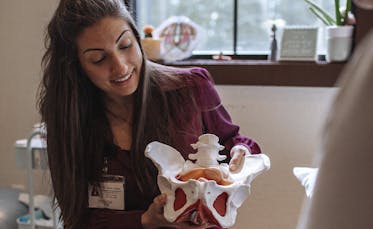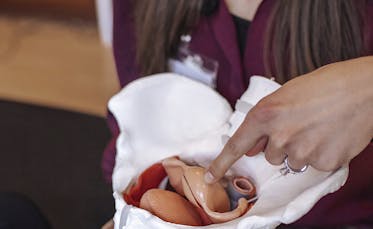General Pelvic Support
It is our mission at Cornerstone Physical Therapy to improve awareness and availability of resources for pelvic conditions in our community. We know that most people have had little experience with physical therapy and many people are not aware that physical therapy is a conservative and successful treatment for many pelvic conditions. Pelvic physical therapy has been an area of specialization for more than 30 years and has been the topic of numerous research studies, which have demonstrated its effectiveness for a wide variety of conditions in both men and women. There are few contraindications for physical therapy treatment and virtually no side effects.Treatable Conditions:
- Post-Hysterectomy/Post-Surgical Pain
- Stress, Urge and Mixed Urinary Incontinence
- Urinary Urgency
- Overactive Bladder
- Coccyx Pain
- Fecal Incontinence
- Pelvic Pain
- Pelvic Organ Prolapse Management
- Dysapareunia (pain with intercourse)
- Vulvodynia and Vulvar Vestibulodynia Syndrome
- Painful Bladder Syndrome/Interstitial Cystitis
- Post-Partum Pain
- Pregnancy-related Pain: hip, back, pelvic, etc.
- Constipation
- Abdominal Pain
- Genital Pain in Males and Females
- Post-Prostate Surgery Pain/Incontinence
- Gender Affirming Care
What You May Expect During Your Physical Therapy Session:
A pelvic floor physical therapy evaluation is very different from the evaluation you receive from your doctor. Physical therapists are experts in assessing muscular tone, strength, flexibility, and endurance, as well as the general health of the musculoskeletal system. Our evaluation of your pelvic floor is very detailed and comprehensive, and the exam often includes an assessment of your back, hips, and any other region of your body that may be involved.Why Choose Cornerstone Physical Therapy:
- Skilled services in a safe, comfortable and private environment
- Excellent communication with your health care providers
- Sound and knowledgeable advice and education about your condition
- A comprehensive assessment and an individualized rehabilitation program
Some Pelvic Health Facts And Resources
Urinary Incontinence (UI), Urgency and Frequency
- Affects over 200 million people worldwide, with 1 in 4 adult women experiencing UI of varying degrees.
- Approximately 20% of men will experience urinary urgency and frequency during their lifetime
- UI is often associated with aging, but it is NOT a normal/natural consequence of aging
- According to the International Continence Society, pelvic physical therapy should be the first treatment option for urinary incontinence.
- Pelvic physical therapy has been shown to produce an improvement in symptoms in over 85% of cases.
- M.R. Knorst et al. 2013;17(5):442-449. doi: 10.1590/S1413-35552012005000117
- A.P. Kruger et al. 2011;15(5):351-356. Rev Bras Fisioter.
Pelvic Pain
- Myofascial pelvic pain (MFPP) is frequently an unrecognized and untreated component of chronic pelvic pain.
- As high as 85% of women with chronic pelvic pain have musculoskeletal dysfunction and postural changes that contribute to their pain.
- Myofascial pelvic pain can be effectively treated with a variety of phyiscal therapy techniques.
- E.A Pastore and W.B. Katzman. 2012;41(5):680-691. doi.10.1111/j.1552-6909.2012.01404.x
Pelvic Organ Prolapse (POP)
- It is estimated that up to 50% of women will experience differing degrees of pelvic organ prolapse (POP)
- Women with POP have reduced strength in their pelvic floor muscles
- Guided pelvic floor muscle training has been shown to significantly improve prolapse symptoms with no adverse side effects
- I.H. Braekken, PhD, PT, et al. 2010;203:170e1-7. doi:10.1016/j.ajog.2010.02.037
What are Kegels?
- A Kegel is a contraction of your pelvic floor muscles and is more accurately called a “pelvic muscle contraction” or a “pelvic muscle exercise”.
- Over 50% of women do not perform the Kegel exercises correctly and up to 25% of women perform them in a way that PROMOTES incontinence.
- When performed properly, Kegel exercises will help you stay active and in control of your bladder and bowel. They will improve your pelvic support, which is especially important with prolapse, after gynecological surgery and childbearing.
Constipation/Dyssynergic Defecation
- Dyssynergic defecation is defined as the inability of patients to relax the muscles required for successful defecation.
- Biofeedback, as a part of pelvic physical therapy treatment, has been shown to be effective in treating this and many other conditions.
What is gender-affirming health care? Why is it important?
The World Health Organization (WHO) defines gender-affirming health care (GAC) as “care [that] can include any single or combination of a number of social, psychological, behavioral or medical (including hormonal treatment or surgery) interventions designed to support and affirm an individual’s gender identity.”
The importance of access to GAC is paramount in the ability of gender queer individuals to not only receive care but also be affirmed in their identity which ensures a greater quality of life. In the 2022 U.S. Trans Survey 48% of respondents had at least one negative encounter with a healthcare provider related to being transgender, and 24% reported not seeking healthcare treatment out of fear of mistreatment.
What aspects of GAC can PTs provide?
The most obvious may be in the case of pre/post-surgical support, such as top or bottom surgery, to optimize function and minimize pain. Although there has been a rise in access to surgical care, many transgender and non-binary individuals do not pursue surgery but do choose to take hormones. For all those receiving some sort of hormonal treatment there may be pelvic health implications to undergoing a shift in the dominant hormone in the body. Also, as the dominant hormone shifts, general muscle and body composition changes might lead to some musculoskeletal pain or joint dysfunction anywhere in the body.
For an Assigned Female at Birth individual taking testosterone, the genitals may undergo changes that could lead to irritability, lack of stretch, pain with sexual activity, changes in bladder/bowel function, or genital/pelvic pain. There may also be growth of the erectile tissue which may be desired but could be painful if the surrounding tissue is not able to accommodate.
For an Assigned Male at Birth individual taking estrogen, the genitals may undergo changes leading to difficulty with erectile function or bladder control. There may also be a change to the muscle tone and sense of support for the pelvis in general.
Outside of the pelvis, individuals might face difficulties with posture/breathing/pain related to binding the chest. Regardless of the impairments or challenges individuals are facing, our therapists at Cornerstone will work with individuals to develop a plan of care to maximize their quality of life and improve their overall health and wellness.
Source:- M. Sherburn et al. 2011;30:317-324. doi:10.1002/nau.20968














